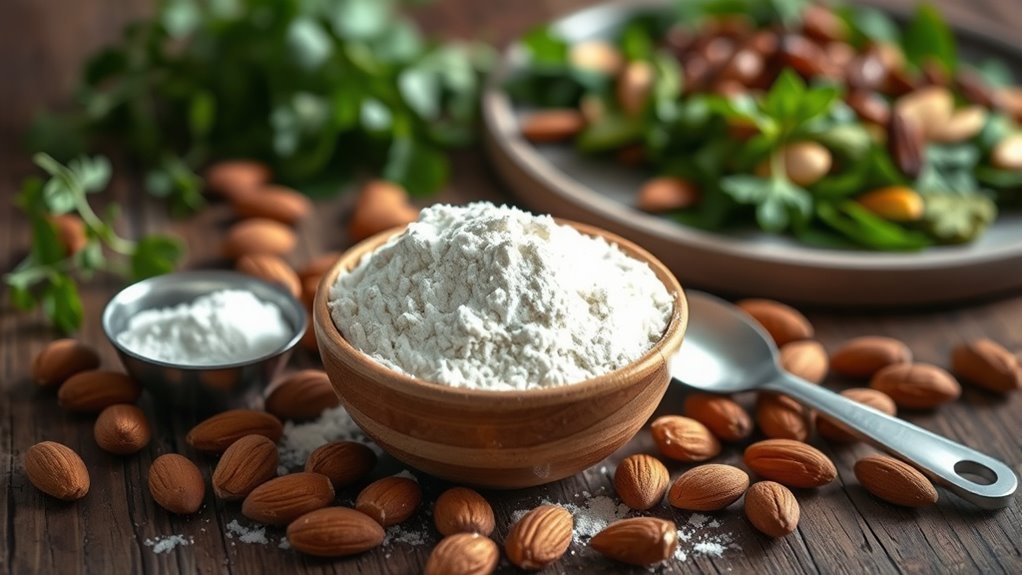Yes, almond flour is keto-friendly! It’s low in carbohydrates—about 10 grams per 100 grams—and high in healthy fats, making it suitable for a ketogenic diet. With rich nutrients like vitamin E and magnesium, it supports overall health while helping you maintain ketosis. Just be mindful of portion sizes to avoid exceeding carb limits. If you’re curious about its health benefits or how to incorporate it into your meals, there’s more to explore.
Nutritional Profile of Almond Flour

When exploring the nutritional profile of almond flour, it’s clear that this ingredient offers a range of benefits for those following a keto diet. Almond flour is low in carbohydrates and high in healthy fats, making it an ideal choice for maintaining ketosis. It’s rich in vitamin E, magnesium, and fiber, which can support heart health and digestion. You can use almond flour in various recipes, from baked goods to breading for meats, enhancing flavor and texture while keeping your carb count in check. Incorporating almond flour into your meals not only diversifies your diet but also provides essential nutrients you may miss on a strict keto plan. Embracing almond flour can empower you to enjoy delicious, satisfying dishes while staying aligned with your health goals. Additionally, using almond flour can help you meet your healthy fat intake, crucial for maintaining ketosis effectively.
Carbohydrate Content and Impact on Ketosis

Although many flours are high in carbohydrates, almond flour stands out as a keto-friendly option due to its relatively low carb content. With about 10 grams of carbohydrates per 100 grams, it allows for effective carb counting, making it easier to fit into your daily macros. Almond flour’s fiber content also helps reduce net carbs, which is vital for ketosis maintenance. When you use almond flour in your recipes, you can indulge without straying too far from your keto goals. However, it’s still essential to measure your portions carefully, as even low-carb options can add up. By incorporating almond flour into your diet mindfully, you can enjoy its versatility while staying committed to your ketogenic lifestyle. Additionally, almond flour supports digestive health and satiety, helping maintain satisfaction and adherence to a keto lifestyle.
Health Benefits of Almond Flour

As you explore the health benefits of almond flour, you’ll find it’s packed with nutrients that can enhance your overall well-being. Almond flour is rich in vitamin E, magnesium, and antioxidants, which support heart health and reduce inflammation. Its high protein and fiber content also aid in digestion and promote satiety, making it a great choice for weight management. Plus, being low in carbohydrates, it aligns well with a keto lifestyle. Incorporating almond flour can also help you enjoy low-carb vegetables while maintaining your dietary goals.
| Nutrient | Health Benefit | Source |
|---|---|---|
| Vitamin E | Antioxidant properties | Almond flour |
| Magnesium | Supports muscle and nerve function | Almond flour |
| Fiber | Aids digestion and satiety | Almond flour |
Incorporating almond flour into your diet can truly promote a healthier you!
How Almond Flour Compares to Other Flours
Almond flour stands out not just for its health benefits but also when compared to other common flours like wheat and coconut flour. In nutritional comparisons, almond flour is lower in carbs and higher in healthy fats, making it a favored choice for keto diets. Unlike wheat flour, which can spike blood sugar levels, almond flour provides a more stable energy source. Coconut flour, while also low in carbs, absorbs more moisture and often requires adjustments in recipes. Both almond and coconut flour serve as viable flour alternatives, but almond flour offers a creamy texture and nutty flavor that many find appealing. Additionally, almond flour contains about 20 grams of carbs per 100 grams, further supporting its role in low-carb diets. Ultimately, your choice may depend on dietary preferences and specific recipe requirements.
Tips for Baking With Almond Flour
When baking with almond flour, accurate measuring is essential to achieve the right texture. You might also need to adjust the liquid ingredients and baking time, as almond flour behaves differently compared to traditional flours. Understanding these tips can help you create successful and delicious keto-friendly baked goods.
Measuring Almond Flour Accurately
To achieve the best results when baking with almond flour, it’s essential to measure it accurately. The accuracy importance can’t be overstated, as even slight variations can affect texture and flavor. To help you measure almond flour effectively, consider these techniques:
- Use a Kitchen Scale: Weighing your flour provides the most precise measurement, ensuring consistency in your recipes.
- Scoop and Level: If you don’t have a scale, spoon almond flour into your measuring cup and level it off with a knife. This prevents packing, which can lead to excess flour.
- Avoid Compressed Flour: When using measuring cups, avoid pressing the flour down. This can create inaccuracies in your measurements.
Adjusting Liquid Ingredients
Adjusting liquid ingredients is essential for achieving the right consistency in your almond flour recipes, especially since almond flour absorbs moisture differently than traditional wheat flour. You’ll want to pay attention to liquid ratios when substituting almond flour for regular flour. Generally, you may need to reduce the amount of liquid by about 25% to achieve a balanced texture. Additionally, consider ingredient adjustments, like adding an extra egg or a bit of nut milk, to help bind your mixture. Remember, too much liquid can lead to a gummy texture, while too little can result in dryness. Experimenting with these adjustments will help you find the perfect balance for your keto-friendly baked goods. Enjoy the freedom to create delicious recipes! Incorporating healthy fats into your baking can further enhance flavor and texture.
Baking Time Adjustments
Baking with almond flour requires some tweaks not just in liquid ingredients but also in baking times. Since almond flour can brown faster, you’ll need to make some baking temperature adjustments and keep an eye on your treats. Here are three helpful tips to manage recipe time variations:
- Reduce Baking Time: Start checking your baked goods 5-10 minutes earlier than the original recipe suggests, as almond flour often cooks quicker.
- Lower the Temperature: If you notice excessive browning, decrease the baking temperature by about 25°F (14°C) to prevent overcooking.
- Use a Toothpick Test: Insert a toothpick in the center; if it comes out clean, your dish is done, even if the time varies from the recipe.
These adjustments will help guarantee delicious outcomes!
Common Recipes Using Almond Flour
While many people are turning to almond flour as a low-carb alternative, it’s also versatile enough to be used in a variety of delicious recipes. You can whip up keto recipes like pancakes, muffins, or bread, all while enjoying unique flavor profiles. Mastering baking techniques with almond flour can enhance your meal prepping, making it easier to stay on track with your dietary considerations. For instance, almond flour works well in cookies, providing a nutty taste that complements chocolate or spices. You might also consider using it in savory dishes like crusts for quiches or coatings for chicken. With its adaptability, almond flour can be a delightful addition to your low-carb culinary adventures.
Potential Drawbacks of Almond Flour
Although almond flour is a popular choice for keto diets, it does come with some potential drawbacks that you should consider. Here are three key points to keep in mind:
- Potential Allergen Concerns: Almonds are a common allergen, so if you have nut allergies, almond flour isn’t a safe option for you.
- Cost Considerations: Almond flour tends to be more expensive than traditional flours, which can add up if you use it frequently in your meal prep.
- Nutritional Imbalance: While almond flour is nutrient-dense, relying too heavily on it might lead to imbalances in your diet, as it lacks certain vitamins and minerals found in other food groups.
Being aware of these factors can help you make informed decisions on your keto journey.
Substituting Almond Flour in Recipes
When you substitute almond flour in recipes, it’s important to evaluate how it behaves differently in baking compared to other flours. You’ll notice variations in flavor and texture, which can enhance or alter your dish. Additionally, comparing the nutritional benefits of almond flour with other options can provide insights into the best choices for your dietary needs. Almond flour is particularly beneficial as it is low in carbs, making it a popular choice for those adhering to a ketogenic diet.
Baking With Almond Flour
Almond flour is a popular choice for those following a keto diet, and it can be easily substituted in various baking recipes. When you’re using almond flour, consider these baking techniques to enhance your creations:
- Mix with Other Flours: Combining almond flour with coconut flour or flaxseed meal can improve texture and flavor in your baked goods.
- Adjust Liquid Ingredients: Almond flour absorbs more moisture than traditional flours, so you may need to increase liquids in your recipes for ideal texture improvements.
- Incorporate Flavor Enhancements: Adding vanilla extract, spices, or citrus zest can elevate the taste of your almond flour recipes and make them even more enjoyable. Utilizing low-carb baking techniques can also lead to satisfying results in your keto-friendly treats.
Experimenting with these variations can lead to delicious, keto-friendly treats that satisfy your cravings!
Nutritional Benefits Comparison
Switching to almond flour in your recipes not only enhances flavor and texture but also brings significant nutritional benefits, especially for those on a keto diet. Almond flour offers lower carbs and higher healthy fats compared to traditional wheat flour, making it a great option for maintaining ketosis. It’s rich in vitamin E, magnesium, and fiber, providing important nutritional advantages over many almond flour alternatives. While coconut flour is another popular choice, it typically requires more liquid and can lead to drier results. By embracing almond flour, you’re not just making a dietary choice; you’re opting for a nutrient-dense ingredient that can elevate your cooking while supporting your health goals. Additionally, almond flour is a great source of healthy fats, which are essential for those following a ketogenic lifestyle. Enjoy the freedom that comes with making informed choices in your kitchen!
Flavor and Texture Differences
While you may be accustomed to using traditional flours, substituting almond flour in your recipes can dramatically alter both flavor and texture. Almond flour has a unique taste profile that adds a subtle nuttiness to your dishes, which can enhance baked goods. However, the texture variations can be significant, affecting the overall outcome. Here are three key points to take into account:
- Moisture Absorption: Almond flour retains moisture differently, leading to denser baked goods.
- Crumb Structure: Expect a coarser crumb, which might not rise as well as wheat flour.
- Flavor Balance: The nuttiness can complement sweet recipes but may overwhelm savory dishes.
Understanding these differences can help you adapt your recipes for the best results. Enjoy the freedom to experiment!
Incorporating Almond Flour Into Your Keto Meal Plan
Incorporating almond flour into your keto meal plan can be a game-changer, especially since it offers a low-carb alternative to traditional flours. Its nutritional uses are vast; almond flour is rich in healthy fats, protein, and fiber, making it a perfect fit for your dietary needs. You can easily use it to create a variety of meal variations, from pancakes and muffins to breaded chicken and pizza crusts. When substituting almond flour for regular flour, remember that it absorbs more moisture, so adjust your liquid ingredients accordingly. You’ll find that experimenting with almond flour can add versatility to your meals while keeping your carb count in check. Additionally, medium-chain triglycerides in coconut milk can complement your almond flour recipes by providing a healthy fat source. Embrace this ingredient, and enjoy the freedom to create delicious, satisfying dishes.
Conclusion: Is Almond Flour Right for You?
After exploring the many ways to incorporate almond flour into your keto meal plan, you might be wondering if it’s the right choice for you. Almond flour offers several benefits, but its keto diet compatibility depends on your specific needs. Consider the following:
- Nutritional Profile: Almond flour is rich in healthy fats, fiber, and protein, making it a nutrient-dense option.
- Blood Sugar Control: Its low glycemic index helps maintain stable blood sugar levels, which is essential for keto dieters.
- Versatility: You can use almond flour in various recipes, from baked goods to breading, allowing for freedom in meal planning.
Additionally, like nutritional yeast, almond flour can enhance your meals with flavor while providing necessary nutrients. Ultimately, if these benefits align with your goals, almond flour can be a valuable addition to your keto lifestyle.
Frequently Asked Questions
Can Almond Flour Be Used in a Vegan Diet?
Absolutely, almond flour can be used in a vegan diet! It’s a great substitute for traditional flours, offering numerous almond flour benefits, like being rich in healthy fats and protein. When it comes to vegan baking, it adds a delightful texture and nutty flavor to your recipes. Just remember to balance it with other ingredients since it can be denser than other flours. Enjoy experimenting with it in your favorite vegan dishes!
Is Almond Flour Gluten-Free?
Yes, almond flour is gluten-free, making it a great option for those with gluten sensitivities or celiac disease. Its health benefits include being high in healthy fats, fiber, and protein, which can support overall well-being. When you’re looking for baking substitutes, almond flour can add a nutty flavor and moist texture to your recipes. Just keep in mind that it behaves differently than traditional flour, so you might need to adjust your measurements.
How Should Almond Flour Be Stored?
To keep almond flour fresh, proper storage is key—did you know that it can last up to a year if stored correctly? Store it in an airtight container in a cool, dark place to control moisture. If you live in a humid area, consider refrigerating or freezing it to prolong its shelf life. By taking these steps, you can enjoy the benefits of almond flour without worrying about spoilage.
What Is the Shelf Life of Almond Flour?
Almond flour typically has a shelf life of about 6 to 12 months when stored properly in a cool, dark place or in the fridge. Its nutritional benefits, like high protein and healthy fats, make it a popular choice for baking uses, especially in gluten-free recipes. Just make sure to check for any off smells or discoloration before using it, as these can indicate spoilage. Enjoy your baking while keeping it fresh!
Can Almond Flour Trigger Nut Allergies?
Yes, almond flour can trigger nut allergies in individuals sensitive to tree nuts. If you’re allergic, consuming almond flour may cause nut allergy symptoms like hives, swelling, or gastrointestinal distress. It’s important to be cautious and consult with a healthcare professional if you have a nut allergy. For those seeking alternatives, consider coconut flour or sunflower seed flour, which can provide similar texture and flavor without the risk of triggering nut allergies.


